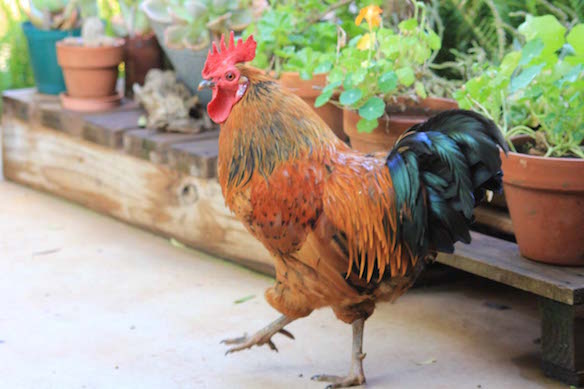I'm not in a good place at the moment. Last Thursday (3rd September 2015) was a bad day for me. I had to have my prize rooster and the love of my girls' life euthanised because he broke his leg during a fight with Peeps, the other rooster in the flock.
Now we all know it's not a good idea to have two roosters together, but I did not know Peeps was a rooster when I rescued him from certain death as a two-day old. He grew up in my studio with Snoodles and when they were both big enough to join the flock, they went outside. Of course Artemis tolerated the youngster, but always letting him understand who's actually King of the roost. And Peeps always obliged, keeping his distance and staying out of harm's way.
Artemis surveying his dominion from his favourite perch, keeping an eye on the girls
But as time progressed and Peeps got bigger and stronger, he wasn't so keen any more to give way and every now and then he would challenge the king, but always ended up retreating to a safe corner.
Artemis has seen it all, been there, done that, sending other rivals packing in great haste. During one such altercation with a previous rooster, Mr. Chook, for whom I had to find a new home because of the constant fighting, Artemis's top part of his beak was broken almost completely off, just hanging by a thread. I glued it back on with some plastic putty and luckily it took and grew back on, the plastic putty dropping off after a few weeks.
Injuries sustained with an earlier altercation with Peeps
Soon he was a good as new and ruling the roost once again with an iron claw.
Artemis was an excellent husband and provider, always finding the best tit-bits and passing them on to one of the girls. Here Hetty came rushing after he found a nice juicy cutworm in the compost heap.
Artemis strutting his stuff on the patio
Artemis surrounded by some of the girls after he called them for a tasty snack he had found
Artemis in full glorious colour after a successful molt
Beauty in motion
Artemis taking one of his few well-deserved breaks after all the girls had settled down for a snooze under the plants
Artemis was also the inspiration for many a sketch I made of him and the girls, who can resist such beauty?
Artemis with his broken leg
After hearing quite a raucous outside one afternoon, the girls cackling and screaming, I went out to see what's happening and everybody was clustered in the centre of the lawn (including Peeps), but Artemis was nowhere to be seen. After a search, I found him under some plants, lying down with his leg at a terrible angle and his comb and neck feathers covered in blood. Obviously there had been a fight, as Peeps was also covered in blood.
I carefully picked Artemis up, hurrying inside with him to assess the damage. After cleaning off all the blood, he seemed perfectly fine, apart from his loosely dangling leg. There was no external damage, but I decided to take him to the vet anyway for an examination. The prognosis was not good and all he could do was give some pain killers and an anti-inflammatory.
For two weeks I kept a close eye on Artemis, despairing at the fact that he could hardly get to the food or water, struggling along, hopping short distances on his one leg and supporting himself with his left wing, tiring quickly and lying down again. During this time, he and the girls were kept in the run with Peeps being banished to a separate coop until Artemis was better.
By last week Thursday, after almost 3 weeks, there was absolutely no improvement and I could feel that he had lost weight. Off to the vet again. It was abvious I had two choices - either have him put down or carry on trying. I contemplated the consequences, both for him and me, if I should go that route of trying, and although my heart was screaming "keep on trying! keep on trying!", I decided that it was not fair to Artemis and that it was better to have him put to sleep.
I held him in my arms as the vet administered the injection and cried and cried as he flapped his last death throes.
Peeps has now taken over the perch from which to keep an eye on the girls and is trying his best to meet the high standards Artemis set, taking little snacks from me and now calling the girls to come and get it in stead of gobbling it up himself like previously.
And so goes the cycle of life on a smallholding...
A loving moment - Kiep, Artemis's favourite wife, gently preening his wounds after a fight with Mr. Chook
::

































